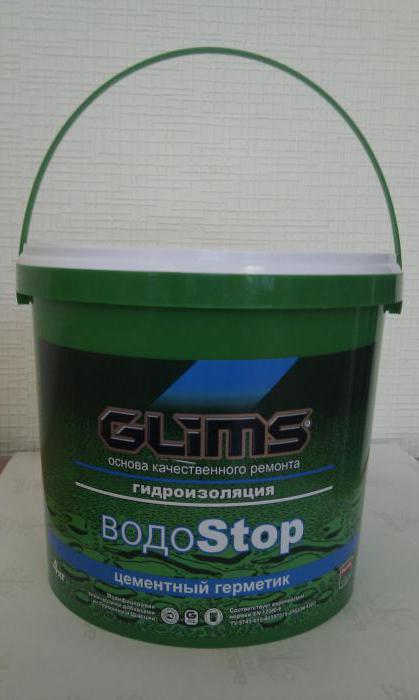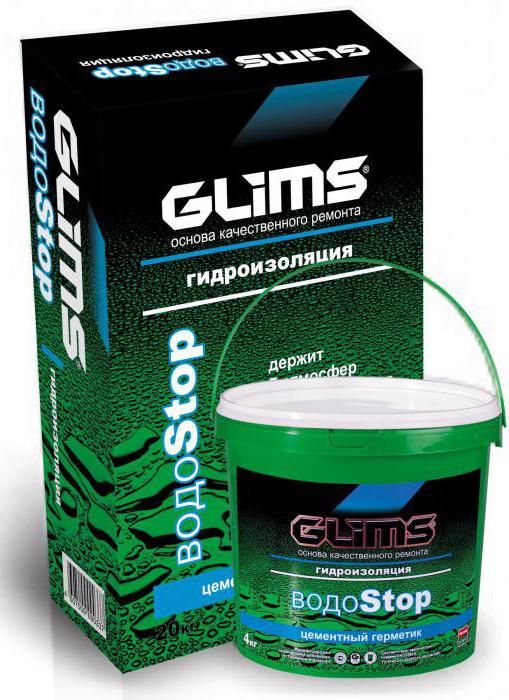Waterproofing materials duringconstruction works are very popular among private and professional consumers. Today they are on sale in a wide range. Among others, we should highlight the material “Vodostop”, which is produced under the brands “Glims” and Ivsil.
The advantages are highadhesion and vapor permeability. After drying, the layer acquires weatherability and high resistance to frost. More information about the material you can read the reviews, as well as recommendations for use.
Areas of use

"Vodostop" - waterproofing, which isa dry cement based compound. It is used to protect buildings inside and out, to seal tanks, pools and tanks that come in contact with drinking water. The material can be used with different materials, this should include:
- plastered surfaces;
- a rock;
- concrete;
- brick.
"Vodostop" - waterproofing, which is popularbecause of its outstanding performance. The material has high adhesion and has a low modulus of elasticity. After drying, the layer has high strength and is resistant to low temperatures. Structures protected in this way can be operated at a temperature range from -50 to +70 ° C.
Key Features

The waterproofing surface remains resistant to:
- alkalis;
- diluted acids;
- gasoline and oil mixtures;
- salt solutions.
Among the additional benefits you needhighlight environmental safety and the possibility of using on wet grounds, but with a note that they should not be wet. The waterproofing “Vodostop” has a rather economical consumption. With a thickness of up to 3 mm per square meter, only 4.5 kg will be needed.
Application features

Waterproofing "Glims Vodostop" should be appliedon the prepared surfaces which are cleared of paint, dust, oil stains and other layers. It is important to make sure that the base is strong enough. It is necessary to apply a primer on a dry surface with a hard-bristled brush, and if the surface is wet, rub the dry mix “Hydraulic seal” into it.
"Vodostop" - waterproofing, the use of whichshould be carried out by a certain technology. Thus, a solution is prepared by pouring the dry mixture into pure water. Per 1 kg of powder will need approximately 0.34 liters of water. If you want to close a 20-kg bag, then it will take about 6.8 liters of liquid.
The mixer needs to be added with a special nozzle,Only after the mixture can be mixed until it reaches the consistency of uniformity. After 10 minutes, the composition must be mixed again, and after mixing, it will remain viable for another 4 hours. It is possible to revive the thickened solution by mixing, water should not be added.
Surface coating

"Glims Vodostop" - waterproofing coating,which should be applied with a spatula or coarse brush. The thickness of the layer should not exceed 3 mm. If it is necessary to form a thicker layer, it is necessary to apply a second layer, but this should be done in a day. The same technology comes from the third.
Each applied layer must dry beforeapplying the next, it will take 24 hours. A dry surface should be wetted, this will allow to identify defects. Laying is carried out perpendicular to each other. For the rooms of bathrooms 2 layers will be enough, but if necessary, waterproofing of the pool can be applied. 3. When constructing new buildings, waterproofing is applied on the external surfaces. At the same time, the ambient temperature should not fall below +5 ° C.
Expense reviews

"Vodostop" - waterproofing, which is appliedmethod of formation of protection in several layers. For example, for the external processing of basements and foundations, it will be necessary to apply two layers, the thickness of the first of which will be 3 mm. According to buyers, in this case the consumption per 1 m2 will be 8 kg.
If you have to process the basement from the inside, thenThe 3-mm layer, according to users, will require 12 kg per square meter. For cesspools, reservoirs, pools and hydraulic structures will need the same amount of composition, while the number of layers should be equal to three.
Consumers emphasize that for tanks,where oil products will be stored during operation, you will need 8 kg per square meter of a three-millimeter layer. The latter will need two. "Vodostop" - waterproofing, which should not be applied to metal painted surfaces. If necessary, consumers are advised to pre-remove the paint.
Reviews of waterproofing "Vodostop" from the manufacturer "Ivsil"

This coating waterproofing ensures waterproof monolithic coatings. The composition contains high-quality materials, namely:
- cement;
- special fractionated filler;
- polymeric additives.
According to consumers, this material canUse for waterproofing cement screed, brickwork, plaster and concrete. If three layers are to be applied, consumers are advised to use a brush, whereas when forming protection in two layers, one should stock up with a spatula. The thickness of the first layer should not exceed 1.5 mm.
The use of waterproofing "Ivsil Vostop"
«Ивсил Водостоп» – гидроизоляция, отзывы о which were presented above and can help you make the right choice. The application of the material should be carried out on the prepared surface, which is smooth and devoid of seams, fractures and cracks.
You can get rid of the damage by specialsolution "Gidroplubba." The strength of the base should be 15 MPa. If we are talking about surfaces made of concrete and brick, then they must be sustained for three months. If you plan to use when applying a spatula, then for 1 kg of dry mixture will need 0.22 liters of water. While using a brush or brush for 1 kg of the composition will need 0.25 liters of water.
Each subsequent layer is applied raw.surface that is not completely dry. To apply the following coatings, the waterproofing layer should dry out, it may take up to two days. Layer thickness is determined depending on the purpose of the room. If the humidity level is increased, and the likelihood of leakage is high, the layer thickness can vary from 1 to 2 mm. If the room is wet enough, and waterproofing surfaces will constantly contact with water, but without pressure, then the layer thickness should be increased to 3 mm. This applies to small fountains and showers.
Conclusion
Protect a building from moisture penetrationquite difficult. This task can be considered responsible. To perform it, only the best materials are selected, which are able to eliminate the contact of surfaces with moisture.
The above waterproofing is suitable foroperations that involve increased attention and control. As a result, you can get a perfectly flat surface, which will not require additional intervention during operation.










